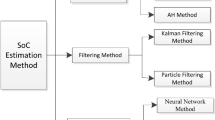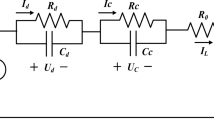Abstract
Electric vehicles Battery management system observes the state of charge of Lithium Ion battery by controlling the parameters such as voltage, current and temperature prevents battery. The purpose of battery management system is used to estimate state of charge for vehicle navigation. This battery management system is useful from over charge and over discharge factors and it leads to cell balancing. An accurate measurement of state of charge estimation in battery management system is important in automotive batteries provides safety. The Kalman filter is proposed to realize the iterative mathematical calculations for estimating state of charge. Sigma point is sampled in the unscented transform using Kalman filter. The imaginary number is generated using this algorithm produces estimation failure. This paper presents a new algorithm, which is an updation of the Unscented Kalman Filter called as an improved unscented Kalman filter proposed which combines the decomposition for calculations and provides accurate estimation of state of charge. Adaptive noise covariance matching method is implemented. Finally, MATLAB simulations are performed to validate the effectiveness of this algorithm.









Similar content being viewed by others
Data Availability
Data sharing not applicable to this article as no datasets were generated or analysed during the current study.
References
Narasipuram, R. P., & Mopidevi, S. (2021). A technological overview & design considerations for developing electric vehicle charging stations. Journal of Energy Storage, 43, 103225.
Electric vehicles: The future of driving. (2010). The consumer electronics association.
Hasan, M. K., Mahmud, M., Habib, A. A., Motakabber, S., & Islam, S. (2021). Review of electric vehicle energy storage and management system: Standards, issues, and challenges. Journal of Energy Storage, 41, 102940.
Ye, M., Song, X., Xiong, R., & Sun, F. (2019). A novel dynamic performance analysis and evaluation model of series-parallel connected battery pack for electric vehicles. IEEE Access, 7, 14256–14265. https://doi.org/10.1109/ACCESS.2019.2892394
Dunn, B., & Tarascon, J. M. (2011). Electrical energy storage for the grid: A battery of choices. Science, 334(6058), 928–935.
Plett, G. L. (2004). Extended Kalman filtering for battery management systems of LiPB-based HEV battery packs part 1 background. Journal of Power Sources, 134(2), 252–261.
Zheng, F., Xing, Y., Jiang, J., Sun, B., Kim, J., & Pecht, M. (2016). Influence of different open circuit voltage tests on state of charge online estimation for lithium-ion batteries. Applied Energy, 183, 513–525.
Khalid, A., Stevenson, A., & Sarwat, A. I. (2021). Performance analysis of commercial passive balancing battery management system operation using a hardware-in-the-loop testbed. Energies, 14, 8037.
Bao, H., & Yu, Y. (2013). Error correction of battery SOC estimation based on ampere-hour integral method. Computing Simulation, 30, 148–151.
Chen, J., Ouyang, Q., Xu, C., & Su, H. (2017). Neural network based state of charge observer design for lithium-ion batteries. IEEE Transactions on Control. Systems Technology, 26, 1–9.
Lei, X., Chen, Q. Q., Liu, K., & Ma, L. (2008). Support vector machine based SOC estimation for electric vehicles. In Proceedings of the CSEE, 28(18), 114–118.
Guo, G. F., Shui, L., Wu, X. L., & Cao, B. G. (2014). SOC estimation for Li-Ion battery using svm based on particle swarm optimization. Advanced Materials, 1051, 1004–1008.
Zhongxiao, Ma., Zongyu, L., & Ming, C. (2006). Application of adaptive Kalman filtering based on fuzzy logic to the integrated GPS/INS navigation. Journal of Information and Control, 35(4), 457–461.
Chen, Y., Li, W., Xin, G., Yang, H., & Xia, T. (2019). An improved strong tracking Kalman filter algorithm for the initial alignment of the shearer. Complexity, 2019, 1–12. https://doi.org/10.1155/2019/3172501
Rahimi-Eichi, H., Ojha, U., Baronti, F., & Chow, M. Y. (2013). Battery management system: An overview of its application in the smart grid and electric vehicles. IEEE Industrial Electronics Magazine, 7(2), 4–16. https://doi.org/10.1109/MIE.2013.2250351
Liu, K., Kang, L., Peng, Q., & Zhang, C. (2018). A brief review on key technologies in the battery management system of electric vehicles. Frontiers of Mechanical Engineering, 14, 47–64.
Lee, S., Kim, J., Lee, J., & Cho, B. H. (2008). State-of-charge and capacity estimation of lithium-ion battery using a new opencircuit voltage versus state-of-charge. Journal of Power Sources, 185(2), 1367–1373.
Baccouche, I., Jemmali, S., Mlayah, A., Manai, B., & Ben Amara, NE. (2018). Implementation of an improved Coulomb-counting algorithm based on a piecewise SOC-OCV relationship for SOC estimation of Li-Ion battery. International Journal of Renewable Energy Resource.
Yoo, H., Sul, S. K., Park, Y., & Jeong, J. (2008). System integration and power-flow management for a series hybrid electric vehicle using supercapacitors and batteries. IEEE Transactions on Industry Applications, 44(1), 108–114. https://doi.org/10.1109/TIA.2007.912749
Chiasson, J., & Vairamohan, B. (2005). Estimating the state of charge of a battery. IEEE Transactions on Control Systems Technology, 13(3), 465–470.
He, W., Williard, N., Chen, C., & Pecht, M. (2013). State of charge estimation for electric vehicle batteries using unscented kalman filtering. Microelectronics Reliability, 53(6), 840–847. https://doi.org/10.1016/j.microrel.2012.11.010
Funding
The authors declare that data supporting the findings of this study are available within the article.
Author information
Authors and Affiliations
Corresponding author
Ethics declarations
Conflict of interest
No potential competing interest was reported by the authors.
Additional information
Publisher's Note
Springer Nature remains neutral with regard to jurisdictional claims in published maps and institutional affiliations.
Rights and permissions
Springer Nature or its licensor holds exclusive rights to this article under a publishing agreement with the author(s) or other rightsholder(s); author self-archiving of the accepted manuscript version of this article is solely governed by the terms of such publishing agreement and applicable law.
About this article
Cite this article
Ananthi, G. State of Charge Estimation in Electric Vehicles Using Improved Strong Tracking Kalman Filter Algorithm. Wireless Pers Commun 128, 147–160 (2023). https://doi.org/10.1007/s11277-022-09946-x
Accepted:
Published:
Issue Date:
DOI: https://doi.org/10.1007/s11277-022-09946-x




